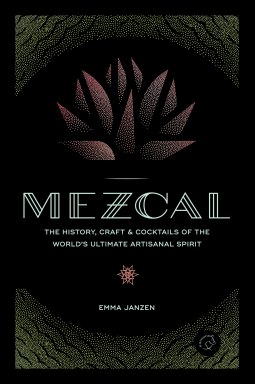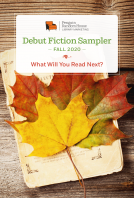
Mezcal
The History, Craft & Cocktails of the World’s Ultimate Artisanal Spirit
by Emma Janzen
This title was previously available on NetGalley and is now archived.
Send NetGalley books directly to your Kindle or Kindle app
1
To read on a Kindle or Kindle app, please add kindle@netgalley.com as an approved email address to receive files in your Amazon account. Click here for step-by-step instructions.
2
Also find your Kindle email address within your Amazon account, and enter it here.
Pub Date Jul 14 2017 | Archive Date Sep 08 2017
Quarto Publishing Group – Voyageur Press | Voyageur Press
Description
*Nominated for the 2018 James Beard Foundation Book Award in the Beverage category*
Produced in Mexico for centuries but little known elsewhere until recent years, mezcal has captured the imagination of spirits enthusiasts with its astonishing complexities. And while big liquor is beginning to jump aboard the bandwagon, most mezcal is still artisanal in nature, produced using small-batch techniques handed down for generations, often with agave plants harvested in the wild.
Join author Emma Janzen as she presents an engaging primer on all things mezcal that includes:
- Mezcal’s long and captivating history in Mexican culture
- The craft of distilling mezcal, from growing and harvesting the agave to roasting and grinding it, all the way to distilling and aging
- A thorough guide to many of the most common agaves used in production and how they shape the resulting spirit
- A selection of nearly 50 cocktails that accentuate mezcal’s distinguishing qualities, contributed by top mezcal bars across the United States and Mexico
With lush photography, an elegant design featuring a foil-debossed cover, and authoritative yet enthralling text, Mezcal is the definitive guide to exploring and unraveling the mysteries of this extraordinary handcrafted spirit.
Available Editions
| EDITION | Other Format |
| ISBN | 9780760352618 |
| PRICE | $26.99 (USD) |
| PAGES | 240 |
Average rating from 5 members
Featured Reviews
 Reviewer 8438
Reviewer 8438
Well-written, thorough, informative. I read this while on a trip to Mexico City and it helped me navigate the world of Mezcal while I was there. Looking forward to exploring more.
Beautiful book about the history of Mezcal an artisinal Mexican spirit that is gaining in popularity around the world. Emma Janzen's book is full of interesting information, stunning photography and tasty cocktail recipes. It is a great resource for those who want to learn more about this unique craft spirit.
 Reviewer 312499
Reviewer 312499
I received this book as a digital advance copy from NetGalley in exchange for an honest review.
I don’t recall ever having tried mezcal, either straight or mixed in a drink. Even worse, I don’t recall ever having a desire to try mezcal. In my mind, mezcal was always been conflated with tequila and, therefore, always assumed to be a low quality liquor that will nauseate me. However, since I did enjoy Rum Curious by the same publisher, I figured I had nothing to lose by reading Mezcal.
The Introduction was a short five pages dedicated to battling the prevailing stereotypes about mezcal. In fact, the author begins her book with the assertion that “[m]ezcal is the most complex spirit in the world.” It is neither bottom shelf rotgut nor “tequila’s mysterious, smoky cousin.” It is “a spirit with a rich cultural heritage and absolutely stunning flavor that’s unmatched in the world of distillation.” Mezcal is made all over Mexico, so the traditions and production secrets differ, resulting in different flavors. How one approaches the production details is almost totally unrestricted across Mexico. However, 95-percent of mezcal exports to the United States are from Oaxaca, so the remainder of the text was largely representative of that area.
The first part, “Meeting Mayahuel,” offered a brief modern history of mezcal as well as a glimpse into the future of mezcal. At the most basic level, mezcal is a distilled spirit that can be made only in Mexico from the heart of the agave plant (the maguey), which must be roasted before it can be transformed into mezcal. Traditional mezcal must be 100-percent agave. The part opens with a visit to a mezcaleria in Oaxaca City, and dumps all the learnings that the author received from the co-owner and mezcal historian. The modern history of mezcal begins in the 1990s when Ron Cooper started Del Maguey as an art project to import mezcal into the United States. From there, it follows the trajectory of the popularity of the spirit in both the United States and Mexico, as well as the effects on local mezcal producers. The future of mezcal contemplates the issues of overharvesting of wild agave plants and disposal of toxic byproducts produced in the mezcal production process.
The second part, “The Nuts and Bolts,” discussed the various species of agave used to make mezcal and the mezcal production process. A finished batch of mezcal is influenced by the time, the suffering, and the terroir of the agave plants used to produce it. According to the author, “[t]he agave is a succulent that struggles to live and lives to struggle.” Up to 50 different varieties of agave are used to make mezcal, while tequila can only be made from the blue weber variety of agave. Although a scientific link between the agave fibers and the expression of terrior has yet to be established, the author believes that the environmental factors must impart characteristics and flavors to the finished mezcal because of the agave plant’s decades long lifespan. The section on the species of agave plants offers a snapshot of trends in the current market and flavor notes compiled from a variety of bartenders and brand owners. Each variety has a short paragraph about the plant as well as a list of bottles to try that are made from that variety. Each bottle listed also has specific tasting notes associated with it. The tasting notes ran a bit odd, with descriptions such as “[c]hocolate, warm squash, and dusty ash,” “elements of damp forest floor,” and “wet stones, lemon peel, and white peppercorn.” The section on the mezcal production process traced mezcal from the sourcing and harvesting of the plants all the way through the distillation and aging of the finished spirit.
The third part, “In the Glass,” focused on drinking mezcal, including how to find the right mezcal, how to select the right glassware for mezcal, and how to garnish a mezcal cocktail. Historically, mezcal is consumed neat, and it is definitely sipped due to its high alcohol content. In order to find the best mezcal for you, the author recommends finding a bartender you trust at a place with a healthy mezcal selection. In absence of that, she recommends tasting flights either by variety, by terroir, by region, or by mezcalero. Options for “glassware” for drinking mezcal include the jicara, which is half of a hollowed out gourd; the veladora, which was originally a container for prayer candles in Mexican Catholic churches; the copita, which is a mezcal specific terracotta drinking cup; and the wine glass. The chapter continues with a buyers’ guide to worm salts designed for accompnying mezcal and concludes with a discussion about pairing food with mezcal.
Approximately twenty-five pages of mezcal cocktails designed for the home bartender were at the heart of the final chapter. First were those cocktails with citrus that get shaken, then those with straight spirits that get stirred, then the highballs with soda, and finally the oddballs. Because of the diversity of flavor profiles across the different styles and brands of mezcal, the author recommends sticking with the brands recommended in the recipes. Each recipe is clearly labeled and accompanied by a full color photograph of the drink. The subtitle below the recipe title gives a succinct summary of the taste of the recipe, like “tart, butter orange kisses roasted agave.” The headnote to each recipe gives a brief description of the recipe’s origin, sometimes in the words of its creator. The recipe ingredients are clearly listed, with brand names used for the mezcal. There are numerous oddball liqueurs and mixers used in the recipes, like Maraschino, Aperol, Averna, Cynar, sloe gin, and velvet falernum. The recipe steps are written in paragraph form, although sometimes they feel like they are out of order because the steps for the syrups and juices that are essential to the drink are listed last. Otherwise, the recipes seem to be easy to follow.
The glossary was an interesting three-page compendium of mezcal related terms, ranging from the well known, like “agave” and “añejo,” to the completely obscure, like “bagasse” and “vinasses.”
In the Acknowledgments, the author characterized her book as a “love letter to mezcal.” Her passion for mezcal truly did come through in the book, as it was obvious that she interviewed a wide variety of mezcaleros, bar tenders, industry professionals, and other interested parties. The book almost got me excited about going to the large liquor store and looking for one of the “beginner” bottles of mezcal so I could see what the fuss is all about. Of course, what is stopping me is the high alcohol percentage, the similarity to tequila, and some of the just plain whacky descriptions of flavor profiles. And I’m really not one for drinking spirits straight – I even put a little water in my Scotch – so it doesn’t sound like mezcal is the spirit for me.
Of course, I would recommend this book to anyone who is interested in learning more about mezcal. It definitely covers pretty much you would want to know about the spirit, its production, and its use in cocktails. It is fairly well written, although a bit too colloquial at times, and the full color photographs add a nice dimension to the work.
 Bejaka C, Reviewer
Bejaka C, Reviewer
At first I thought this book would be a dense historicalesque novel, however, I was delighted by Jansen's light, poetic and descriptive style as well as the photos that accompanied it. In addition to that, she further highlights the unique cultural identity of this traditional spirit by accenting her book with Spanish words as she delves into the process involved in making Mezcal. Through her words, we traverse through the modern history of the spirit complete with the genus and species of several agave plants used in making Mezcal along with the various categories of classification to very extensive descriptions of the flavors present at each stage in the creation cycle. The reader is given two gifts in the third half of the book: first, various drink recipes for us to try out if we ever manage to obtain this blessed remnant of Montezuma's treasure; secondly, the addresses of several locations in America and in Mexico for us to visit as well as a few places online to buy this delicious Ambrosia. I for one am sincerely looking forward to trying out this nectar the next time I visit Louisiana. I raise my glass to Emma Janzen, for this wonderfully written cultural treatise. Salud!
Readers who liked this book also liked:
Kalan Chapman Lloyd
General Fiction (Adult), Literary Fiction, Women's Fiction






